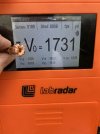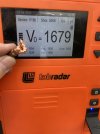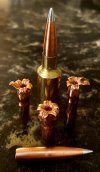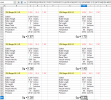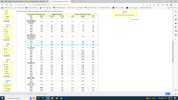nralifer
Well-Known Member
Bullet stability is fundamental to not only accuracy but also to effective deep penetration. A marginally stable bullet mey group well at 100 yds but start to tumble at 300. Also, bullets are less stable at sea level than at 5000 ft, BECAUSE AT SEA LEVEL THE AIR DENSITY THEY ARE TRAVELING IN IS HIGHER THAN AT 5000 FT. Likewise, when a bullet enters an animal the density of the medium it is traveling in SUDDENLY INCREASES well beyond the air it traveled through to get there. To achieve as straight a line of penetration as possible and adequate bullet expansion, the bullet must be traveling nose forward and not tumbling. The barrel twist rate and muzzle velocity impart to the bullet the rotational speed (RPM) that determines the stability. This rotational speed is entirely separate from its forward speed (FPS). This latter speed degrades much more quickly than the rotational speed as it is a function of the bullet BC whereas the rotational speed is not, for all practical considerations. It is the rotational speed measured as RPMs, that determines the stability of the bullet through air AND the target medium, whether that be tissue or ballistic gel.
The following is an illustration of the effect MV has on rotational speed of a bullet. Consider a 30 cal bullet shot through a 1:10 twist barrel first at 1700 fps an then at 3000 fps. At 1700 fps the bullet leaves the barrel rotating at 122,400 rpm. At 3000 fps the bullet rotational speed is now 216,000 rpm, a difference of 93,600 rpm. In air over a short distance the slower bullet may be stable enough to hit nose foreward, but as it enters a much denser medium (10% gel for instance) it will start to tumble almost immediately and not expand properly. Not only that, but the path the tumbling bullet will follow is much more erratic. Proper gel testing of bullet expansion demands that the bullet, in its trek through the gel, be spinning at a high enough RPM to keep it traveling nose forward.
These principles also apply to subsonic loads. They require a tighter twist barrel to impart the proper RPMs to the bullet to keep it stable over several hundreds of yards.
The following pictures show a .284 160 gr BD2 expansion at reduced muzzle velocities. All were shot from a 1:7 twist barrel.
The following is an illustration of the effect MV has on rotational speed of a bullet. Consider a 30 cal bullet shot through a 1:10 twist barrel first at 1700 fps an then at 3000 fps. At 1700 fps the bullet leaves the barrel rotating at 122,400 rpm. At 3000 fps the bullet rotational speed is now 216,000 rpm, a difference of 93,600 rpm. In air over a short distance the slower bullet may be stable enough to hit nose foreward, but as it enters a much denser medium (10% gel for instance) it will start to tumble almost immediately and not expand properly. Not only that, but the path the tumbling bullet will follow is much more erratic. Proper gel testing of bullet expansion demands that the bullet, in its trek through the gel, be spinning at a high enough RPM to keep it traveling nose forward.
These principles also apply to subsonic loads. They require a tighter twist barrel to impart the proper RPMs to the bullet to keep it stable over several hundreds of yards.
The following pictures show a .284 160 gr BD2 expansion at reduced muzzle velocities. All were shot from a 1:7 twist barrel.
Attachments
Last edited:

